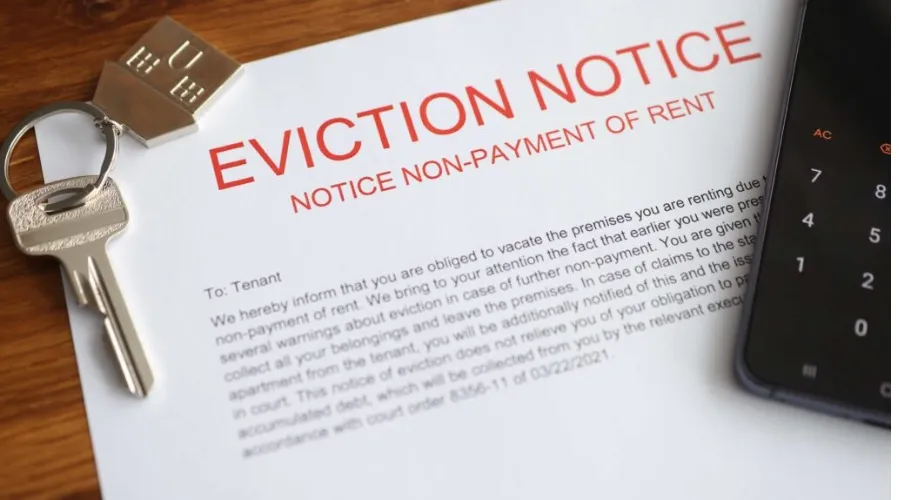The eviction process in Delaware requires landlords to follow strict legal steps-even when there’s no lease involved. From serving proper notice to avoiding illegal eviction tactics, every action must align with Delaware landlord-tenant laws. This guide from LeaseRunner walks you through what to do (and what not to do) to remove a tenant the right way, while protecting your rights and avoiding costly mistakes.
Recent Legal Updates for 2025 Delaware Eviction Laws
Delaware made two key changes in 2025 that impact how landlords can evict tenants. If you’re a property owner or renter, here’s what these legal updates mean for your rights and responsibilities.
Abolition of No-Fault Evictions (Section 21)
Starting in 2025, Delaware will no longer allow no-fault evictions. Landlords must now provide a clear legal reason—such as nonpayment of rent or major lease violations—before starting the eviction process. This change applies to most residential leases and is designed to protect tenants from being removed without cause.
While the new law makes the eviction process in Delaware more regulated, it doesn’t take away landlords’ rights. You can still evict tenants for valid legal grounds, but you’ll need to follow stricter procedures and provide proper documentation. The shift promotes fairness in landlord-tenant relationships and encourages accountability on both sides.
Eviction Record Shielding (SB 115)
Under Senate Substitute 2 for SB 115, which passed in June 2025 and is currently awaiting the Governor’s signature, Ohio renters may soon gain the right to shield past eviction records from public view under certain conditions.
Specifically, if all amounts owed have been fully paid and no additional eviction filings have occurred within five years, the tenant may file a motion with the court requesting to have the record sealed from public access. Once granted, the sealed record would no longer be visible in public background checks or databases, helping renters avoid long-term housing discrimination based on a resolved, isolated incident.
However, the record would remain accessible to the courts, the Department of Justice, and the tenant involved. The goal of this legislation is to provide a path to stability and second chances for tenants who have resolved past issues and demonstrated no repeated violations.
Valid Reasons for Eviction in Delaware (2025)
Under Delaware landlord-tenant law, evictions can only occur for legally recognized reasons. Below are the most common grounds landlords can use to start a lawful eviction process.
Failure to pay rent on time
When a tenant fails to pay rent on time, Delaware landlords can issue a 5-Day Notice to Pay or Quit. This gives the renter five days to clear the full balance or move out.
If the payment is made during this window, the lease continues without interruption. If not, the landlord has the right to file a Summary Possession action in court. Landlords should retain rent logs, delivery proof, and a valid lease agreement as evidence if filing in court.
Important documents to retain:
- A signed lease agreement
- Detailed rent payment records
- Copy of the notice and delivery confirmation
![Eviction process starts if rent isn’t paid on time]() Lease violations
Lease violations
Common lease violations—like keeping an unauthorized pet or causing disturbances—can trigger the eviction process in Delaware if not corrected in time. In these cases, landlords must serve a 7-Day Notice to Comply or Vacate.
Typical lease breaches include:
- Smoking in non-smoking units
- Repeated noise complaints
- Overcrowding or subletting without approval
If the tenant corrects the problem within the allowed time, the eviction can’t proceed. Always collect dated proof, like photos or written complaints.
Illegal activity conduct
Delaware law permits immediate action if a tenant is involved in criminal conduct such as drug-related offenses, violence, or unlawful possession of weapons. In these cases, landlords can issue a Notice to Quit Immediately-no grace period is required.
Valid reasons for immediate eviction:
- Drug activity
- Physical threats or violence
- Using the unit for illegal purposes
Landlords should prepare solid evidence (e.g., police reports, witness accounts) before filing for eviction.

Non-renewal of lease after lease expiration
When a tenant refuses to leave after the lease expires, they’re considered a holdover tenant. For month-to-month leases, landlords must give a 60-day Written Notice to Vacate. If you're unsure about timing or notice requirements, refer to this breakdown of Delaware lease-breaking laws.
If the tenant does not move out by the deadline, the landlord may proceed with an eviction filing.
Key reminders:
- Send the notice before the lease ends
- Keep proof of notice delivery and the lease termination date
If the tenant refuses to vacate, landlords may begin the formal eviction process in Delaware through the court system.
Property damage
If a tenant causes serious property damage beyond normal wear and the landlord can issue a 7-Day Notice to Vacate. This type of damage is non-correctable.
Be sure to document incidents carefully and compare the damage with standards under Delaware security deposit law to support your claim.
Examples include:
- Broken windows or doors
- Holes punched in walls
- Water damage due to negligence
Landlords in Delaware can legally evict tenants who cause significant damage that goes beyond normal wear and tear. To start the legal eviction process in Delaware, you’ll need solid proof—photos, repair bills, or inspection reports that clearly show the tenant caused the damage. Delaware rental laws require proper documentation; acting without it can delay the process or even lead to legal trouble for landlords.
How to Provide an Eviction Notice in Delaware: A Complete Guide
Providing an eviction notice in Delaware must comply with the Delaware Residential Landlord-Tenant Code (Title 25, Delaware Code). This guide outlines the types of notices, content requirements, delivery methods, and legal considerations for 2025.
Types of notice in Delaware
Under Delaware law, landlords must give the right type of eviction notice depending on why they’re ending the tenancy. Providing proper notice is the first legal step in the eviction process in Delaware, and failing to do so can delay or invalidate the entire case.
- 5-Day Notice to Pay or Quit (Nonpayment): For tenants who fail to pay rent on time. Tenants must pay all owed amounts within 5 days or vacate, or the landlord may file for eviction. Per SB 116 (pending full Senate approval in 2025), tenants may avoid eviction by paying before the eviction date.
- 7-Day Notice to Cure or Quit (Lease Violations): For lease violations (e.g., unauthorized pets, occupants, or noise). Tenants have 7 days to correct the issue or vacate.
- 7-Day Notice to Quit (Illegal Activity or Property Damage): For illegal activities (e.g., drug-related or violent acts) or willful/grossly negligent property damage. No cure option is provided.
- 60-Day Notice for At-Will Tenancies or Non-Renewal: For month-to-month tenancies or lease non-renewal after expiration. Tenants must vacate within 60 days.
Notice content requirements
Every step in the eviction process in Delaware begins with a legally compliant notice that states why the tenant is being removed. Every eviction notice must include:
- Tenant’s name and property address.
- Specific reason for eviction (e.g., non-payment, lease violation details, illegal activity).
- Notice period and action required (e.g., pay rent, cure violation, or vacate).
- Landlord’s name, contact information, and signature.
- Date of notice issuance.
- Statement that failure to comply may lead to eviction proceedings in the Justice of the Peace Court.
- For lease violations, reference the specific lease clause breached, if applicable.
Notice delivery methods
Delaware law (25 Del. C. § 5513) allows the following delivery methods, each with pros and cons:
- Hand Delivery: The notice is handed directly to the tenant or a responsible person at the residence or business.
- Pros: Direct, immediate, and verifiable if delivered in person; provides clear proof of receipt.
- Cons: May lead to confrontation; requires the landlord or agent to locate the tenant.
- Posting (Substituted Service): Posting on the property if no one is available to receive the notice, or leaving with a suitable person at the tenant’s residence/business.
- Pros: Effective when the tenant is unavailable; legally acceptable.
- Cons: Less certain proof of receipt; may be challenged if not properly documented.
- Certified Mail (with Return Receipt): The notice is mailed through USPS with tracking and proof that the tenant received it.
- Pros: Provides documented proof of mailing and receipt; non-confrontational.
- Cons: Tenant may refuse delivery; delays due to mail processing.

Legal considerations before moving forward
Before taking legal action, landlords must consider several key factors to ensure the eviction process in Delaware follows state law and avoids unnecessary delays or legal risks.
- Verify valid grounds: Ensure the eviction reason complies with Delaware law (e.g., non-payment, lease violations, illegal activity, property damage, or non-renewal).
- Fair housing compliance: Avoid discriminatory practices based on race, color, religion, sex, disability, familial status, or national origin, per federal and Delaware fair housing laws.
- Lease agreement review: Confirm the lease supports the eviction reason and notice period; check for any specific notice requirements in the lease.
- Documentation: Documentation is crucial in the eviction process in Delaware, especially when filing a case in the Justice of the Peace Court.
- Tenant protections: Be aware of tenant rights, such as income-eligible tenants’ access to free legal representation (per SS1 for SB1, 2023) and the ability to shield eviction records after 5 years under SB 115 (2025, pending Governor’s signature).
- Court preparation: If the tenant does not comply, be prepared to file for summary possession in the Justice of the Peace Court, including all required documentation (notice, lease, proof of service).
- Consult legal resources: Consider consulting an attorney or the Delaware Division of Human and Civil Rights for complex cases or to ensure compliance.
Before taking legal action, double-check that your lease terms and your chosen notice type match. For situations involving delayed repairs or property conditions, it's also essential to understand your obligations under Delaware landlord-tenant repair law.
Eviction Process in Delaware: Step-by-Step Guide (2025)
The eviction process in Delaware, governed by the Delaware Residential Landlord-Tenant Code, involves specific steps to ensure compliance with 2025 laws. Below is a step-by-step guide for landlords seeking to evict a tenant.
Step 1 – Serve proper eviction notice
Deliver a written eviction notice based on the reason for eviction:
- Non-payment of rent: 5-day notice to pay or quit.
- Lease violations: 7-day notice to cure or quit.
- Illegal activity or property damage: 7-day notice to quit (no cure).
- Month-to-month tenancy or non-renewal: 60-day notice.
- Foreclosure-related: 90-day notice.
Include the tenant’s name, property address, reason for eviction, notice period, landlord’s contact info, signature, date, and a statement about potential court action.
Step 2 – Landlord file dispossessory affidavit
If the tenant does not comply within the notice period, file a summary possession action in the Justice of the Peace Court.
Requirements:
- Submit a dispossessory affidavit detailing the eviction reason, lease terms, and notice served.
- Include copies of the lease, eviction notice, and proof of service.
- Pay applicable court filing fees.
Timing: File promptly after the notice period expires to initiate court proceedings.
Step 3 – Serve summons & affidavit
The court issues a summons, which must be served on the tenant along with a copy of the dispossessory affidavit.
Delivery Methods:
- Hand delivery by a constable, sheriff, or authorized agent.
- Posting on the property if the tenant cannot be located.
- Certified mail, if permitted by the court.
Purpose: Notifies the tenant of the court hearing date (typically within 10-15 days) and their right to respond.
Step 4 – Attend court hearing
Both landlord and tenant attend the summary possession hearing in the Justice of the Peace Court.
Process:
- Landlord presents evidence (e.g., lease, notice, payment records).
- Tenant may present a defense or counterclaim; income-eligible tenants may access free legal representation (per SS1 for SB1, 2023).
- The judge rules based on evidence and Delaware law.
Outcome: If the landlord prevails, the court issues a judgment for possession.
Step 5 – Obtain writ of possession
If the tenant doesn’t vacate, the eviction process in Delaware allows landlords to request a writ of possession through the court. Authorizes a constable or sheriff to remove the tenant and their belongings if they do not leave voluntarily.
Timing: Typically issued within 10 days of the judgment.
Step 6 – Regain possession
The constable or sheriff executes the Writ of Possession, overseeing the tenant’s removal and returning the property to the landlord. Landlords cannot forcibly remove tenants, change locks, or remove belongings without court authorization. Once the tenant is removed, the landlord regains full possession of the property.
Eviction Timeline and Costs in Delaware (2025)
Understanding the full timeline and costs of the eviction process in Delaware helps landlords plan ahead and stay compliant. Below is a table detailing each stage, duration, and costs for 2025.
Essential Documents as Delaware Landlords
Proper documentation is critical for Delaware landlords to ensure compliance with the Delaware Residential Landlord-Tenant Code (Title 25, Delaware Code) and to support eviction or legal proceedings in 2025. Below are best practices and key evidence types for landlords.
Best practices for record keeping
Consistency and accuracy are key when it comes to managing tenant files. Follow these foundational habits to maintain a strong legal position:
- Create individual tenant files: Keep all essential documents-leases, notices, payment logs-in clearly labeled folders (digital or paper).
- Timestamp everything: Log dates and times for inspections, notice deliveries, and tenant communication.
- Keep backup copies: Retain duplicates of all critical records for at least three years, including court paperwork and signed leases.
- Store securely: Use encrypted cloud storage or locked filing cabinets to protect confidential tenant data.
- Document communication: Summarize every email, text, or verbal exchange, noting dates and outcomes to avoid future disputes.

Evidence to support nonpayment claims
To legally pursue eviction for nonpayment, you’ll need more than just your word. These documents help prove the tenant failed to pay rent on time:
- Signed lease agreement: Details rent amount, payment due dates, and applicable late fees.
- Payment logs or bank records: Clearly show payment history, missed payments, and amounts due.
- Late payment reminders: Send and save written notices prior to issuing a formal 5-day notice to pay or quit.
- Official 5-day notice: Must list tenant’s name, rental address, balance owed, and proof of delivery (e.g., certified mail).
- Communication history: Save messages or emails showing your effort to resolve the payment issue.
Evidence for lease violations
When a tenant breaks the lease, proper documentation helps avoid disputes and supports your right to terminate the agreement. Here’s what to prepare:
- Lease agreement copy: Highlight violated terms, such as no-pet clauses or guest restrictions.
- Written complaints: Collect reports from other tenants or staff regarding noise, unauthorized pets, or similar issues.
- Photos/videos: Capture timestamped evidence of the violation, including where and when it occurred.
- 7-day notice to cure or quit: Clearly state the breach, cite the violated clause, and include service proof.
- Witness testimony: If available, gather signed statements from neighbors or employees who witnessed the behavior.
Property condition documentation
Clear before-and-after evidence of property condition protects your security deposit claims. It also supports damage-related evictions.
- Inspection checklists: Use clear move-in/move-out forms. Complete them with tenants present. Support findings with photos or videos.
- Repair records: Log maintenance requests, vendor receipts, and timeframes of completed work.
- Damage documentation: Photograph damage beyond ordinary wear and tear-ensure images are timestamped.
- Routine inspection notes: Maintain summaries from regular walk-throughs, ideally acknowledged by the tenant.
- 7-day notice to quit for property damage: Include specific damage details, delivery method, and legal notice period.
Landlord Mistakes To Avoid In Delaware Eviction Cases
Delaware law requires landlords to follow strict rules during the eviction process. Here are key missteps to avoid:
Self-eviction
You can’t lock out tenants, shut off utilities, or remove their things without a Writ of Possession. Only a sheriff or constable can enforce an eviction-doing it yourself can lead to legal trouble and fines.
Improper notice or service
Serving incorrect notices or using the wrong delivery methods can disrupt the eviction process in Delaware. This can happen even if your reason for removal is valid.
Ignoring tenant protections
Evictions can’t be based on discrimination or retaliation. Delaware law protects tenants who report issues or belong to protected classes. Violating this can lead to lawsuits, especially with new legal aid access under SB1 (2023).
Bottom Line
Evicting a tenant in Delaware with or without a lease requires strict compliance with state laws. Landlords must provide proper notice, file court paperwork, and avoid any form of self-help eviction. Failing to follow the legal process can delay removal and expose you to legal liability.
If you're facing unpaid rent, property damage, or ending a month-to-month lease, knowing the eviction process in Delaware is key. This helps you protect your rights and stay legal. For more tools and resources to manage your rentals, check out LeaseRunner’s Delaware landlord guide.
FAQs
How to Evict a Tenant in Delaware Without a Lease?
Even if there’s no lease, Delaware law still protects tenants. For month-to-month or at-will tenants, landlords must serve a 60-day written notice to end the tenancy. Skipping this step can delay the eviction process.
Fastest Way to Evict a Tenant in Delaware?
In urgent cases, like serious lease violations or health and safety threats, landlords may give an Immediate Quit Notice. This can lead to a quicker court process, but only applies in limited situations within the formal eviction process in Delaware.
What Landlords Cannot Do in Delaware?
Delaware law strictly forbids self-help eviction. That means no changing locks, cutting utilities, or using intimidation tactics. All evictions must go through the court, or landlords risk legal penalties.

 Lease violations
Lease violations

